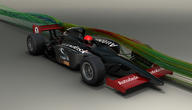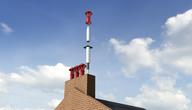
BioLite has developed both a CampStove and HomeStove that use some of the excess heat energy of a fire to generate electricity.
This electricity is both used to run a fan that increases the efficiency of the fire while reducing emissions through more complete combustion, as well charge portable devices, such as cell phones or LED lights.
Utilizing patented technology developed in-house, BioLite has developed products that can both help make for a more fun and easy time for campers, as well as a healthier and safer life for people cooking on open fires in poor countries.
Autodesk Software Used:
Self-feeding Fire
First conceived in 2006, the BioLite CampStove was designed with the idea of using some of the excess energy inherent in a campfire to help feed the fire itself. A heat probe extracts energy that creates electricity to power a fan that forces more air into the combustion chamber.
Figure 1: Electricity Generation and Fire Feeding Loop
This concept of using waste energy to feed the system (like a turbocharger in a car) can help both increase efficiency and reduce emissions.Using the excess electricity created can also help charge any USB charging device, like a cellphone or MP3 player.
Figure 2: Flow and Temperature Through the Stove
Heat Probe Engineering Optimization
Heat to Electricity: BioLite developed a special heat probe that draws a controlled amount of heat from the fire to a thermoelectric generator (or TEG). The engineering design of the heat probe was critical: too little heat and the TEG wouldn’t work properly, too much and it would burn out.
Design Considering Materials: Materials selection was an important part of this process. As with all engineering challenges, there were important tradeoffs. Initially, BioLite specified that the probe be made of aluminum, due to its light weight and low cost. However, the probe was found to melt due to the extremely high temperatures of the fan-fed fire. This required a redesigned probe incorporating more costly copper, which made the design function as intended.
Engineering Software: CFD was used throughout the design process to insulate the generation area from the combustion chamber while still letting in the heat through the probe. It was also useful in the prototyping phase to help understand how the placement of the air holes could affect the combustion properties.
Figure 3: Flow and Temperature in the Combustion Chamber
CFD and Combustion Optimization
Laminar vs. Turbulent Flow: It was important to attempt to design the chamber to experience turbulent flow, rather than smooth laminar flow. This is because turbulence allows for much greater mixing. This mixing makes sure that there is oxygen available in all parts of the chamber, creating complete combustion. Too much oxygen, however, would cause cooling of the system, and therefore a lower overall efficiency. The final design of the stove balances these aspects well, creating a near complete combustion without cooling.
Interpreting the Results: In Figure 4, we see a CFD model of the combustion chamber with vectors showing the air flow and colors representing the temperature. The flow is well distributed through the jets at the top, apart from where there are no jets near the heat probe. The air that goes halfway around the circumference of the chamber gets pre-heated more before being jetted into the combustion region.
The Ideal Solution: A perfectly optimized version would have equal flow through all jets and equal temperatures. A bad version would show poor air delivery through some jets (perhaps on the opposite side of the power pack) and uneven temperature distribution.
Figure 4: Using the CampStove
CampStove: Creating a Compelling Value Proposition to Campers
Reliability: Another challenge faced by the design team was reliability, as there were considerations concerning weight and costs. BioLite also needed to prioritize aesthetics and product safety. For instance, while it may have been cheaper to use certain components, BioLite determined their product needed a very long lifetime, and so decided to incorporate more robust parts when building their stove.
Total Cost of Ownership: Because the CampStove uses fuel that can be found while camping, rather than petroleum fuels, which must be purchased, the cost of their stove over its lifetime is significantly lower than an equivalently priced gas stove.
Safety: BioLite solved one safety issue by using a metal mesh, which remains cooler than the surrounding material. The mesh does this in two ways. First, it stays cool because it is separated from the combustion chamber, eliminating conductive heating. Secondly, it allows air to easily pass around it, greatly enhancing convective cooling. It is also aesthetically pleasing.
Figure 5: The BioLite HomeStove Being Tested in Ghana
HomeStove: Reducing emissions while creating a context-appropriate product
Helping Families in Developing Countries: BioLite conceptualized their product goals differently in developing their HomeStove for developing countries. The main goal for this product was to reduce emissions, which, according to the World Health Organization, cause two million deaths a year.
Cost and Reliability: The Most Important Design Requirements: In order to create a viable product for developing countries, BioLite needed to keep the costs low, as people purchasing the stove have very little income. To complicate matters, reliability was a huge concern, as this product would constitute a major purchase for many of its users. Additionally, these stoves are intended to have much higher use intensity, as they are used daily to cook multiple large meals. Unlike the CampStove, weight was less of a priority, as users would not have to carry their stove and actually liked the added stability of a heavier product. However, aesthetics remained important, as to gain meaningful adoption, the stove needed to be perceived as an aspirational product by end users.
Benefits of the Use-Specific Design: The final design for the HomeStove was a great success, resulting in over a 94% reduction in smoke emissions, along with a 91% reduction in carbon monoxide, while cutting fuel consumption by half compared to a standard three stone fire (the standard cooking method in many developing nations).The design also allows for wood to be fed from the side, which improved usability. It is consistent with how most people in the developing world currently cook and lets the cook keep the pot on the fire while adding more fuel.
Figure 6: The CampStove in Action
A Finished Product: By using sustainable design practices, along with user-centered designs and excellent engineering, BioLite has managed to develop two very exciting products that can help people around the world.
Links
http://techcrunch.com/2011/07/08/biolite-stove-charges-your-phone/
http://www.thecoolist.com/biolite-campstove-and-usb-charger/
http://scienceline.org/2012/05/the-smokeless-stove/
http://www.nytimes.com/2012/05/21/arts/21iht-design21.html?_r=1&smid=pl-...
Software Exercise
- Download Simulation CFD for FREE from the Autodesk Student website.
- Open Simulation CFD and click on the button labeled tutorials.
- Select “Electronics: Forced Convection” under “Example Models”
- Follow the steps to understand the basics of how temperature analysis with forced convection can be run in Simulation CFD











